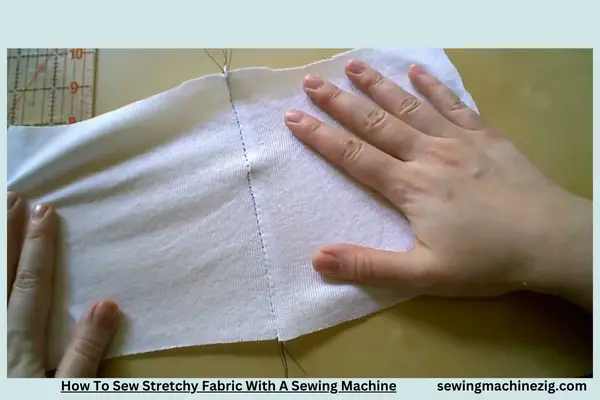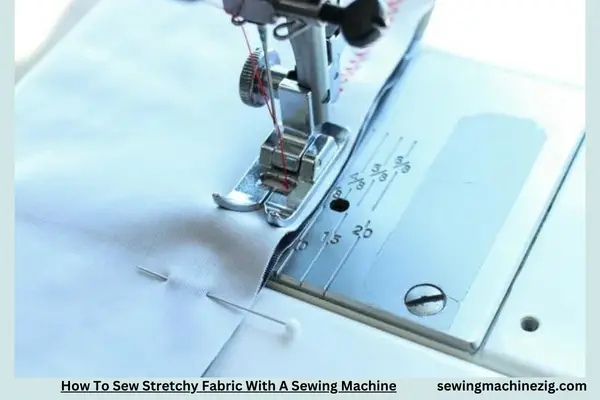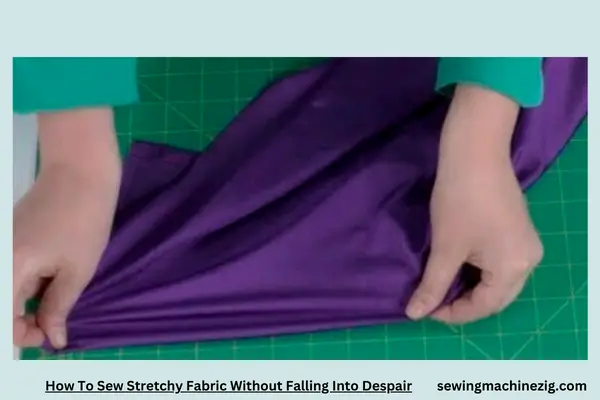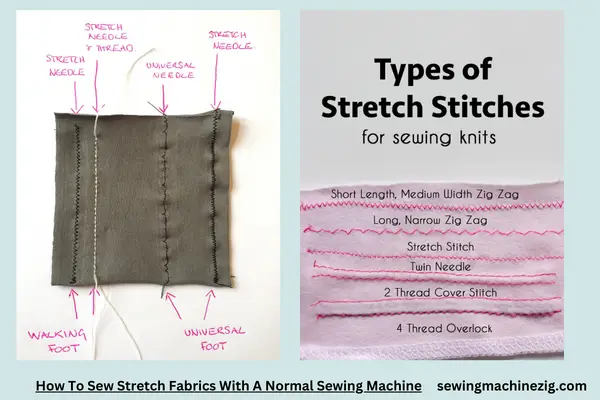
Embarking on a project with stretchy fabric opens up a realm of possibilities in the sewing world. However, navigating the nuances of sewing stretchy fabrics requires a specialized approach.
In this comprehensive guide, we’ll unravel the secrets of handling stretchy materials with your sewing machine. From choosing the right stitches to adjusting tension settings, mastering the art of sewing stretchy fabrics is crucial for achieving professional-looking results. Whether you’re a seasoned seamstress or a novice, this guide will walk you through the essential techniques, providing valuable insights on “How To Sew Stretchy Fabric With A Sewing Machine.”
How To Sew Stretchy Fabric With A Sewing Machine Detailed Answer

Sewing with stretchy fabrics demands a nuanced approach to ensure the final garment not only fits well but also maintains its elasticity. Let’s delve into a comprehensive step-by-step guide on “How To Sew Stretchy Fabric With A Sewing Machine.”
Select the Right Needle:
- Begin by choosing a ballpoint or stretch needle. These needles have a rounded tip, preventing snags or damage to the fabric’s fibers.
Thread Selection:
- Opt for a polyester or nylon stretch thread that complements the fabric’s elasticity. This ensures the seams move seamlessly with the garment.
Adjusting Stitch Type:
- Use a stretch stitch, zigzag stitch, or a narrow and elongated straight stitch to accommodate the fabric’s stretch without compromising the seam’s integrity.
Test on Scrap Fabric:
- Before diving into your project, test the selected needle, thread, and stitch on a scrap piece of the same stretchy fabric. Adjust settings as needed for optimal results.
Handling Fabric with Care:
- Gently guide the fabric through the machine, avoiding excessive pulling or stretching. Use both hands to support the fabric, promoting even feeding.
Foot Choice Matters:
- Consider using a walking foot or a Teflon foot to prevent the fabric from sticking to the presser foot. This ensures smooth and consistent stitching.
Tension Adjustment:
- Experiment with tension settings to find the right balance. The correct tension prevents puckering while maintaining the fabric’s stretch.
Seam Finishing:
- For a professional finish, consider using a serger or an overcasting stitch to prevent fraying. Alternatively, a zigzag stitch can serve as an effective seam finish.
Elastic Insertion:
- If your project involves elastic, use a zigzag stitch to attach it securely. Ensure the elastic is stretched slightly as you sew to maintain the fabric’s stretchiness.
Avoiding Excessive Backstitching:
- Minimize backstitching at the beginning and end of seams to prevent stiffness. Instead, tie off the threads for a flexible and comfortable finish.
Pressing with Caution:
- Use a low heat setting on your iron or a pressing cloth when necessary. Excessive heat can adversely affect the fabric’s elasticity.
Choosing the Right Project:
- Consider the nature of your project. Items like activewear, leggings, or swimwear demand a higher degree of stretch, requiring careful attention to sewing techniques.
Practicing Patience:
- Sewing stretchy fabrics may require a bit more time and patience. Take breaks, reassess your work, and proceed with a steady hand.
Handling Different Stretch Levels:
- Be mindful of varying degrees of stretch in different fabrics. Adjust your sewing machine settings accordingly when transitioning between materials.
Finishing Touches:
- Once your project is complete, try it on and assess the fit. Make any necessary adjustments to ensure both comfort and style.
By following these step-by-step guidelines, “How To Sew Stretchy Fabric With A Sewing Machine” ” you can confidently navigate the intricacies of sewing stretchy fabrics with your sewing machine. The key lies in understanding your materials and equipment, allowing you to create garments that not only look great but also feel comfortable and move seamlessly with the body.
How To Sew Stretchy Fabric Without Falling Into Despair

Sewing stretchy fabrics can be a bit challenging, but with the right approach, you can tackle it without feeling overwhelmed.
Here’s a simple guide on how to sew stretchy fabric without falling into despair:
Choose the Right Needle:
- Start by selecting a ballpoint or stretch needle. These needles are designed for knit fabrics and will help prevent snags and damage.
Use the Right Thread:
- Opt for a polyester or nylon stretch thread. These threads have some give, allowing the seams to stretch without breaking.
Adjust Your Stitch:
- Set your sewing machine to a stretch stitch or a narrow zigzag stitch. These stitches accommodate the stretch of the fabric without causing it to pucker or break.
Test on Scrap Fabric:
- Before working on your actual project, practice on a scrap piece of the same stretchy fabric. This allows you to adjust your machine settings and get comfortable with the material.
Handle with Care:
- When sewing, gently guide the fabric through the machine. Avoid pulling or stretching it excessively. Use both hands to support the fabric and maintain an even feed.
Consider a Walking Foot:
- If you have a walking foot for your sewing machine, use it. This foot helps the layers of fabric move together smoothly, preventing uneven stretching.
Adjust Tension:
- Experiment with your machine’s tension settings. Proper tension prevents the fabric from puckering and ensures a balanced and stretchy seam.
Use a Stabilizer:
- If your fabric is exceptionally stretchy, consider using a stabilizer or clear elastic tape along the seam. This provides extra support and helps maintain the fabric’s shape.
Size Down Your Needle:
- If you notice skipped stitches or the fabric isn’t feeding properly, try using a smaller needle size. Sometimes, a smaller needle works better with stretchy fabrics.
Practice Patience:
- Sewing stretchy fabrics may require a bit more time and patience. Take breaks if needed, reassess your work, and proceed with a steady hand.
Press with Caution:
- When pressing seams, use a low heat setting on your iron or a pressing cloth. Excessive heat can damage the elasticity of the fabric.
Consider a Serger:
- If you have access to a serger, it’s an excellent tool for sewing stretchy fabrics. Sergers create finished edges and provide extra stretch to the seams.
Use a Twin Needle:
- For hems and topstitching, consider using a twin needle. This creates a professional-looking finish and allows for a bit of stretch.
Check Your Machine’s Manual:
- Always refer to your sewing machine’s manual for specific tips and recommendations. Manufacturers often provide valuable insights on sewing different fabrics.
Celebrate Small Wins:
- As you work through your project, celebrate small successes. Every well-sewn seam is a step closer to conquering stretchy fabrics without despair.
Remember, practice makes perfect. The more you work with stretchy fabrics, the more comfortable and confident you’ll become. Don’t be discouraged by initial challenges, and embrace the learning process with a positive mindset.
How To Sew Stretch Fabrics With A Normal Sewing Machine

Sewing stretchy fabric and creating lovely gathers or ruffles can seem daunting, but with the right approach, it becomes an enjoyable process. Here’s a simple guide on “How To Sew Stretchy Fabric With A Sewing Machine” while incorporating the steps for gathering fabric and making ruffles:
Choose the Right Needle and Thread:
- To sew stretchy fabric successfully, start by selecting a ballpoint or stretch needle and a polyester or nylon stretch thread. These choices ensure your stitches accommodate the fabric’s elasticity.
Set Your Machine to a Stretch Stitch:
- Adjust your sewing machine to a stretch stitch or a narrow zigzag stitch. This stitch type allows the fabric to stretch without compromising the seam’s integrity.
Practice on Scrap Fabric:
- Before working on your main project, practice on a scrap piece of the same stretchy fabric. This helps you familiarize yourself with the machine settings and ensures you get comfortable working with stretch fabrics.
Choose the Right Fabric for Gathering:
- If you’re planning to gather fabric, opt for a lightweight fabric. Lighter fabrics gather more easily and create beautiful, soft ruffles.
Use a Longer Stitch Length for Gathering:
- When creating gathers, set your machine to a longer stitch length. This makes it easier to pull the threads and gather the fabric evenly.
Sew Two Rows of Parallel Stitches:
- For gathering, sew two rows of parallel stitches along the fabric where you want the gathers. Leave long thread tails at the beginning and end of each row.
Pull the Threads to Create Gathers:
- Gently pull the bobbin threads on each end to gather the fabric. Distribute the gathers evenly, adjusting until you achieve the desired fullness.
Secure the Gathers:
- Once you’re satisfied with the gathers, knot the thread tails securely at both ends to secure the gathers in place.
For Ruffles, Adjust Stitch Length:
- To create ruffles, set your machine to a shorter stitch length. This makes the fabric gather more tightly, forming distinct ruffles.
Sew a Single Row of Stitches:
- Unlike gathering, for ruffles, sew a single row of stitches along the fabric where you want the ruffle. Again, leave long thread tails.
Pull the Thread to Create Ruffles:
- Gently pull one of the thread tails to gather the fabric into lovely ruffles. Adjust the gathers until you achieve the desired ruffle density.
Secure the Ruffles:
- Knot the thread tails securely at one end to secure the ruffles in place. This ensures they stay intact during subsequent sewing steps.
Practice Patience and Celebrate Success:
- Sewing stretchy fabric, gathering, and making ruffles may take some practice. Be patient with the process and celebrate your successes along the way.
By following these steps, you’ll not only learn “How To Sew Stretchy Fabric With A Sewing Machine” but also master the art of gathering fabric and creating delightful ruffles. With a bit of practice, you’ll confidently add these charming details to your sewing projects.
Conclusion
In conclusion, conquering “How To Sew Stretchy Fabric With A Sewing Machine” empowers you to confidently navigate the realm of flexible materials. This skill ensures your stitches accommodate the stretch, providing comfortable and durable results.
The keyword highlights the significance of adapting your sewing techniques to handle stretchy fabrics seamlessly. With the right approach, your sewing machine becomes a versatile tool, capable of producing professional-looking garments that not only fit well but also stand the test of comfort and style in the dynamic world of fashion and textiles.
FAQS
Q: Can I use a regular needle when sewing stretchy fabric with a sewing machine?
A: It’s recommended to use a ballpoint or stretch needle when sewing stretchy fabric with a sewing machine. These needles are specifically designed to prevent skipped stitches and fabric damage.
Q: How do I prevent puckering when sewing stretchy fabric on a sewing machine?
A: To prevent puckering, adjust the machine’s tension settings, use a stretch stitch, and test on scrap fabric first. Refer to “How To Sew Stretchy Fabric With A Sewing Machine” for detailed guidance on minimizing puckering.
Q: Can I sew different types of stretchy fabrics with the same settings on my sewing machine?
A: While some settings may work for various stretchy fabrics, it’s advisable to test settings on a scrap piece of each fabric. Factors like weight and elasticity can influence the ideal settings.
Q: Is it necessary to pre-treat stretchy fabric before sewing on a sewing machine?
A: Pre-treating stretchy fabric, such as washing and drying it, can help eliminate shrinkage before sewing. Follow the fabric care instructions and pre-treat as needed for optimal results. “How To Sew Stretchy Fabric With A Sewing Machine“
Q: What type of stitch is best for sewing stretchy fabric on a sewing machine?
A: A stretch stitch or a narrow zigzag stitch is ideal for sewing stretchy fabric. These stitches accommodate the fabric’s stretch while maintaining a strong and flexible seam. “How To Sew Stretchy Fabric With A Sewing Machine“



